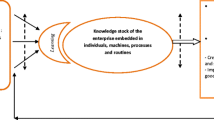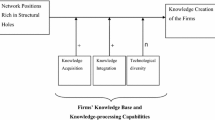Abstract
Knowledge convergence is an important means of innovation. The study aims to explore how knowledge convergence influences innovation performance at an organizational level. Furthermore, we address the moderating role of network relational embeddedness on the innovation deriving from knowledge convergence. Our empirical analyses adopting negative binomial regression models employ patent counts and patent citations from the nanotechnology field. The findings reveal that the scientific intensity in the convergence between scientific knowledge and technological knowledge has an inverted U-shaped influence on innovation performance and that this association is flattened in organizations with high network relational diversity. Also, we find that the technological scope in convergence of technological knowledge self has an inverted U-shaped influence on innovation performance and that this association is steepened in organizations with high network relational strength. Our findings add understandings of knowledge convergence on organization innovation and also have important practical and political implications.



Similar content being viewed by others
References
Ahuja, G., & Katila, R. (2004). Where do resources come from? The role of idiosyncratic situations. Strategic Management Journal, 25, 887–907.
Aiken, L. S., West, S. G., & Reno, R. R. (1991). Multiple regression: Testing and interpreting interactions. Thousand Oaks: Sage.
Arora, S. K., Porter, A. L., Youtie, J., & Shapira, P. (2013). Capturing new developments in an emerging technology: An updated search strategy for identifying nanotechnology research outputs. Scientometrics, 95, 351–370.
Athreye, S., & Keeble, D. (2000). Technological convergence, globalisation and ownership in the UK computer industry. Technovation, 20, 227–245.
Belderbos, R., Cassiman, B., Faems, D., Leten, B., & Van Looy, B. (2014). Co-ownership of intellectual property: Exploring the value-appropriation and value-creation implications of co-patenting with different partners. Research Policy, 43, 841–852.
Brooks, H. (1994). The relationship between science and technology. Research Policy, 23, 477–486.
Cardinal, L. B., Alessandri, T. M., & Turner, S. F. (2001). Knowledge codifiability, resources, and science-based innovation. Journal of knowledge management, 5, 195–204.
Carnabuci, G., & Operti, E. (2013). Where do firms’ recombinant capabilities come from? Intraorganizational networks, knowledge, and firms’ ability to innovate through technological recombination. Strategic Management Journal, 34, 1591–1613.
Cassiman, B., Veugelers, R., & Zuniga, P. (2008). In search of performance effects of (in) direct industry science links. Industrial and Corporate Change, 17, 611–646.
Caviggioli, F. (2016). Technology fusion: Identification and analysis of the drivers of technology convergence using patent data. Technovation, 55, 22–32.
Chen, J.-R., Kan, K., & Tung, I. H. (2016). Scientific linkages and firm productivity: Panel data evidence from Taiwanese electronics firms. Research Policy, 45, 1449–1459.
Curran, C.-S., & Leker, J. (2011). Patent indicators for monitoring convergence-examples from NFF and ICT. Technological Forecasting and Social Change, 78, 256–273.
Dawson, J. F. (2014). Moderation in management research: What, why, when, and how. Journal of Business and Psychology, 29, 1–19.
Demirkan, I., Deeds, D. L., & Demirkan, S. (2013). Exploring the role of network characteristics, knowledge quality, and inertia on the evolution of scientific networks. Journal of Management, 39, 1462–1489.
Fleming, L. (2001). Recombinant uncertainty in technological search. Management Science, 47, 117–132.
Fleming, L., & Sorenson, O. (2004). Science as a map in technological search. Strategic Management Journal, 25, 909–928.
Grant, R. M. (1996). Toward a knowledge-based theory of the firm. Strategic Management Journal, 17, 109–122.
Guan, J. C. (2002). Comparison Study on Industrial Innovation between China and Some European Countries. Production and Inventory Management Journal, 43(3/4), 30–46.
Guan, J. C., & Liu, N. (2015). Invention profiles and uneven growth in the field of emerging nano-energy. Energy Policy, 76, 146–157.
Guan, J. C., & Liu, N. (2016). Exploitative and exploratory innovations in knowledge network and collaboration network: A patent analysis in the technological field of nano-energy. Research Policy, 45, 97–112.
Guan, J. C., & Pang, L. X. (2018). Bidirectional relationship between network position and knowledge creation in Scientometrics. Scientommetrics, 115, 201–222.
Guan, J. C., Zhang, J. J., & Yan, Y. (2017). A dynamic perspective on diversities and network change: partner entry, exit and persistence. International Journal of Technology Management, 74, 221–242.
Haans, R. F., Pieters, C., & He, Z. L. (2016). Thinking about U: Theorizing and testing U-and inverted U-shaped relationships in strategy research. Strategic Management Journal, 37, 1177–1195.
Hacklin, F., Battistini, B., & Von Krogh, G. (2013). Strategic choices in converging industries. MIT Sloan Management Review, 55, 65.
Hohberger, J. (2016). Diffusion of science-based inventions. Technological Forecasting and Social Change, 104, 66–77.
Jeong, S., & Lee, S. (2015). What drives technology convergence? Exploring the influence of technological and resource allocation contexts. Journal of Engineering and Technology Management, 36, 78–96.
Karvonen, M., & Kässi, T. (2013). Patent citations as a tool for analysing the early stages of convergence. Technological Forecasting and Social Change, 80, 1094–1107.
Lee, W. S., Han, E. J., & Sohn, S. Y. (2015). Predicting the pattern of technology convergence using big-data technology on large-scale triadic patents. Technological Forecasting and Social Change, 100, 317–329.
Lee, Y. G., Lee, J. H., Song, Y. I., et al. (2008). Technological convergence and open innovation in the mobile telecommunication industry. Asian Journal of Technology Innovation, 16(1), 45–62.
Lee, C., Park, G., & Kang, J. (2016). The impact of convergence between science and technology on innovation. The Journal of Technology Transfer, 1, 1–23.
Levinthal, D. A., & March, J. G. (1993). The myopia of learning. Strategic Management Journal, 14, 95–112.
Liu, N. (2017). Complex innovation network in nano-energy (pp. 1–226). Beijing: Economic Science Press.
Liu, N., Mao, J. Q., & Yu, G. S. (2017). Exploration and prospect on technological convergence studies. Science Research Management, 38(12), 20–28.
Liu, N., Wu, X. Y., & Mao, J. Q. (2019). The impact of inventors’ ego-networks dynamic on knowledge searching. Studies in Science of Science, 37(4), 689–700.
Maine, E., Thomas, V. J., & Utterback, J. (2014). Radical innovation from the confluence of technologies: Innovation management strategies for the emerging nanobiotechnology industry. Journal of Engineering and Technology Management, 32(4–6), 1–25.
Mcfadyen, M. A., & Cannella, A. A. (2004). Social capital and knowledge creation: Diminishing returns of the number and strength of exchange relationships. Academy of Management Journal, 47, 735–746.
Mcfadyen, M. A., Semadeni, M., & Cannella, A. A., Jr. (2009). Value of strong ties to disconnected others: Examining knowledge creation in biomedicine. Organization Science, 20, 552–564.
Nelson, R. R., & Winter, S. G. (2009). An evolutionary theory of economic change. Harvard: Harvard University Press.
Nerkar, A., & Shane, S. (2003). When do start-ups that exploit patented academic knowledge survive? International Journal of Industrial Organization, 21, 1391–1410.
No, H. J., & Park, Y. (2010). Trajectory patterns of technology fusion: Trend analysis and taxonomical grouping in nanobiotechnology. Technological Forecasting and Social Change, 77, 63–75.
Petruzzelli, A. M., Rotolo, D., & Albino, V. (2015). Determinants of patent citations in biotechnology: An analysis of patent influence across the industrial and organizational boundaries. Technological Forecasting and Social Change, 91, 208–221.
Roco, M. C., & Bainbridge, W. S. (2013). The new world of discovery, invention, and innovation: convergence of knowledge, technology, and society. Journal of Nanoparticle Research, 15, 1.
Rojas, M. G. A., Solis, E. R. R., & Zhu, J. J. (2018). Innovation and network multiplexity: R&D and the concurrent effects of two collaboration networks in an emerging economy. Research Policy, 47(6), 1111–1124.
Rosenberg, N. (1963). Technological change in the machine tool industry, 1840–1910. The Journal of Economic History, 23(4), 414–443.
Rost, K. (2011). The strength of strong ties in the creation of innovation. Research Policy, 40, 588–604.
Schilling, M. A., & Phelps, C. C. (2007). Interfirm collaboration networks: The impact of large-scale network structure on firm innovation. Management Science, 53, 1113–1126.
Schumpeter, J. A. (1961). The theory of economic development: An inquiry into profits, capital, credit, interest, and the business cycle. Translated by Redvers Opie: Harvard University Press.
Simon, H. A. (1991). Bounded rationality and organizational learning. Organization Science, 2, 125–134.
Singh, J. (2008). Distributed R&D, cross-regional knowledge integration and quality of innovative output. Research Policy, 37, 77–96.
Trajtenberg, M., Henderson, R., & Jaffe, A. (1997). University versus corporate patents: A window on the basicness of invention. Economics of Innovation and New Technology, 5, 19–50.
Van Der Vegt, G. S., & Bunderson, J. S. (2005). Learning and performance in multidisciplinary teams: The importance of collective team identification. Academy of Management Journal, 48, 532–547.
Van Vianen, B., Moed, H., & Van Raan, A. (1990). An exploration of the science base of recent technology. Research Policy, 19, 61–81.
Von Raesfeld, A., Geurts, P., Jansen, M., Boshuizen, J., & Luttge, R. (2012). Influence of partner diversity on collaborative public R&D project outcomes: A study of application and commercialization of nanotechnologies in the Netherlands. Technovation, 32, 227–233.
Wang, J. (2016). Knowledge creation in collaboration networks: Effects of tie configuration. Research Policy, 45, 68–80.
Wang, C., Rodan, S., Fruin, M., & Xu, X. (2014). Knowledge networks, collaboration networks, and exploratory innovation. Academy of Management Journal, 57, 484–514.
Acknowledgements
This study is supported by the Grants from National Natural Science Foundation of China (Nos. 71874176, 71702090, 71672103). The authors are very grateful for the valuable comments and suggestions from two anonymous reviewers and the Editor of the Journal, which significantly improved the quality of the paper.
Author information
Authors and Affiliations
Corresponding author
Rights and permissions
About this article
Cite this article
Liu, N., Mao, J. & Guan, J. Knowledge convergence and organization innovation: the moderating role of relational embeddedness. Scientometrics 125, 1899–1921 (2020). https://doi.org/10.1007/s11192-020-03684-2
Received:
Published:
Issue Date:
DOI: https://doi.org/10.1007/s11192-020-03684-2




